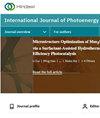Multicluster Analysis and Design of Hybrid Wireless Sensor Networks Using Solar Energy
IF 2.1
4区 工程技术
Q3 CHEMISTRY, PHYSICAL
引用次数: 9
Abstract
A wireless touch network is a distributed, self-organizing network of multiple sensors and actuators in combination with multiple sensors and a radio channel. Also, the security area of such a network can be several meters to several meters. The main difference between wireless sensor networks from traditional computer and telephone networks is the lack of a fixed infrastructure owned by a specific operator or provider. Each user terminal in a touch network is capable of acting as a terminal device only. Despite the long history of sensor networks, the concept of building a sensor network is not finally imposed and expressed in some software and hardware (platform) solutions. In this paper, the design and analysis of multicluster model of the sensor nodes in wireless sensor network with the help of solar energy. This proposed model provides the required energy to transmit the information between two end nodes in different cluster. The communication between the end to end clusters was increased based on this design. The implementation of sensory networks at the current stage depends largely on the specific needs of the industrial problem. The architecture, software, and hardware implementation technology is at an intensive development stage, attracting the attention of developers looking for a technological niche of future makers.太阳能混合无线传感器网络的多集群分析与设计
无线触摸网络是多个传感器和执行器与多个传感器和无线电信道相结合的分布式、自组织网络。另外,这种网络的安全区域可以是几米到几米。无线传感器网络与传统计算机和电话网络的主要区别在于,无线传感器网络没有固定的基础设施,由特定的运营商或提供商拥有。触摸网络中的每个用户终端只能作为终端设备。尽管传感器网络有着悠久的历史,但构建传感器网络的概念最终并没有在一些软件和硬件(平台)解决方案中被强加和表达。本文对太阳能无线传感器网络中传感器节点的多簇模型进行了设计和分析。该模型提供了在不同集群的两个端节点之间传输信息所需的能量。基于这种设计,增加了端到端集群之间的通信。现阶段感官网络的实施在很大程度上取决于工业问题的具体需要。架构、软件和硬件实现技术正处于密集发展阶段,吸引了寻找未来创客技术利基的开发人员的关注。
本文章由计算机程序翻译,如有差异,请以英文原文为准。
求助全文
约1分钟内获得全文
求助全文
来源期刊
CiteScore
6.00
自引率
3.10%
发文量
128
审稿时长
3.6 months
期刊介绍:
International Journal of Photoenergy is a peer-reviewed, open access journal that publishes original research articles as well as review articles in all areas of photoenergy. The journal consolidates research activities in photochemistry and solar energy utilization into a single and unique forum for discussing and sharing knowledge.
The journal covers the following topics and applications:
- Photocatalysis
- Photostability and Toxicity of Drugs and UV-Photoprotection
- Solar Energy
- Artificial Light Harvesting Systems
- Photomedicine
- Photo Nanosystems
- Nano Tools for Solar Energy and Photochemistry
- Solar Chemistry
- Photochromism
- Organic Light-Emitting Diodes
- PV Systems
- Nano Structured Solar Cells

 求助内容:
求助内容: 应助结果提醒方式:
应助结果提醒方式:


